A UAV Wind Field Perception System Inspired by Biological Perception
Abstract
1. Introduction
2. Wind Field Calculation Method and Measurement System Construction
2.1. Three-Dimensional Wind Field Calculation Method Based on UAV
2.2. Axis System Conversion and Solution
Body Axis System—Ground Axis System
2.3. Wind Field Measurement System Scheme Design
2.4. Wind Tunnel Experiment of Wind Field Measurement System
- Airspeed meter calibration and evaluation experiment
- Angle sensor calibration
2.5. Three-Dimensional Wind Field Measurement System Flight Test
3. Results
3.1. The Results of the Wind Tunnel Experiment
3.1.1. Calibration Curve of On-Board State Airspeed Meter
3.1.2. Side Slip Angle Calibration Experiment Results
3.1.3. Angle of Attack Calibration Curve
3.2. The Results of the Flight Experiment
4. Discussion
Analysis of the Attack Angle’s Lateral Features
5. Conclusions
Author Contributions
Funding
Institutional Review Board Statement
Informed Consent Statement
Data Availability Statement
Conflicts of Interest
References
- Gupta, S.G.; Ghonge, D.; Jawandhiya, P.M. Review of Unmanned Aircraft System (UAS). SSRN Electron. J. 2013, 2, 9. [Google Scholar] [CrossRef]
- Rayleigh. The Soaring of Birds. Nature 1883, 27, 534–535. [Google Scholar] [CrossRef]
- Richardson, P.L. How do albatrosses fly around the world without flapping their wings? Prog. Oceanogr. 2011, 88, 46–58. [Google Scholar] [CrossRef]
- Alerstam, T.; Gudmundsson, G.A.; Larsson, B. Flight Tracks and Speeds of Antarctic and Atlantic Seabirds: Radar and Optical Measurements. Philos. Trans. R. Soc. B Biol. Sci. 1993, 340, 55–67. [Google Scholar]
- Weimerskirch, H. GPS Tracking of Foraging Albatrosses. Science 2002, 295, 1259. [Google Scholar] [CrossRef] [PubMed]
- Weimerskirch, H.; Wilson, R.P. Oceanic respite for wandering albatrosses. Nature 2000, 406, 955–956. [Google Scholar] [CrossRef] [PubMed]
- Wakefield, E.D.; Phillips, R.A.; Matthiopoulos, J.; Fukuda, A.; Higuchi, H.; Marshall, G.J.; Trathan, P.N. Wind field and sex constrain the flight speeds of central-place foraging albatrosses. Ecol. Monogr. 2009, 79, 663–679. [Google Scholar] [CrossRef]
- Quindlen, J.; Langelaan, J. Flush Air Data Sensing for Soaring-capable UAVs. In Proceedings of the 51st AIAA Aerospace Sciences Meeting, Grapevine, TX, USA, 7–10 January 2013. [Google Scholar]
- Sachs, G.; Bussotti, P.; Zaslavski, A. Application of Optimal Control Theory to Dynamic Soaring of Seabirds. In Variational Analysis and Applications. Nonconvex Optimization and Its Applications; Springer: Boston, MA, USA, 2005. [Google Scholar]
- Sachs, G.; Traugott, J.; Nesterova, A.P.; Dell’Omo, G.; Kümmeth, F.; Heidrich, W.; Vyssotski, A.L.; Bonadonna, F. Flying at No Mechanical Energy Cost: Disclosing the Secret of Wandering Albatrosses. PLoS ONE 2012, 7, e41449. [Google Scholar] [CrossRef] [PubMed]
- Sachs, G.; Traugott, J.; Nesterova, A.P.; Bonadonna, F. Experimental verification of dynamic soaring in albatrosses. J. Exp. Biol. 2013, 216 Pt 22, 4222–4232. [Google Scholar] [CrossRef] [PubMed]
- Egger, J.; Bajrachaya, S.; Heinrich, R.; Kolb, P.; Lämmlein, S.; Mech, M.; Reuder, J.; Schäper, W.; Shakya, P.; Schween, J.; et al. Diurnal Winds in the Himalayan Kali Gandaki Valley. Part III: Remotely Piloted Aircraft Soundings. Mon. Weather Rev. 2002, 130, 2042–2058. [Google Scholar] [CrossRef]
- Egger, J.; Bajrachaya, S.; Egger, U.; Heinrich, R.; Reuder, J.; Shayka, P.; Wendt, H.; Wirth, V. Diurnal Winds in the Himalayan Kali Gandaki Valley. Part I: Observations. Mon. Weather Rev. 2000, 128, 1106–1122. [Google Scholar] [CrossRef]
- Zängl, G.; Egger, J.; Wirth, V. Diurnal winds in the Himalayan Kali Gandaki valley. Part II: Modeling. Mon. Weather Rev. 2001, 129, 1062–1080. [Google Scholar] [CrossRef]
- van den Kroonenberg, A.; Martin, T.; Buschmann, M.; Bange, J.; Vörsmann, P. Measuring the Wind Vector Using the Autonomous Mini Aerial Vehicle M2AV. J. Atmos. Ocean. Technol. 2008, 25, 1969–1982. [Google Scholar] [CrossRef]
- Spiess, T.; Bange, J.; Buschmann, M.; Vörsmann, P. First application of the meteorological Mini-UAV ‘M2AV’. Meteorol. Z. 2007, 16, 159–169. [Google Scholar] [CrossRef] [PubMed]
- Shimura, T.; Inoue, M.; Tsujimoto, H.; Sasaki, K.; Iguchi, M. Estimation of Wind Vector Profile Using a Hexarotor Unmanned Aerial Vehicle and Its Application to Meteorological Observation up to 1000 m above Surface. J. Atmos. Ocean. Technol. 2018, 35, 1621–1631. [Google Scholar] [CrossRef]
- Holland, G.J.; Mcgeer, T.; Youngren, H. Autonomous aerosondes for economical atmospheric soundings anywhere on the globe. Bull. Am. Meteorol. Soc. 1992, 73, 1987–1998. [Google Scholar] [CrossRef]
- Holland, G.J.; Webster, P.J.; Curry, J.A.; Tyrell, G.; Gauntlett, D.; Brett, G.; Becker, J.; Hoag, R.; Vaglienti, W. The Aerosonde robotic aircraft: A new paradigm for environmental observations. Bull. Am. Meteorol. Soc. 2001, 82, 889–902. [Google Scholar] [CrossRef]
- Li, J.; Zhang, M.; He, C.; Hua, X.; Li, Y. Wind field measurement and data processing methods of atmosphere UAV based on aerodynamic angle. Intell. Comput. Appl. 2019, 9, 107–111. [Google Scholar]


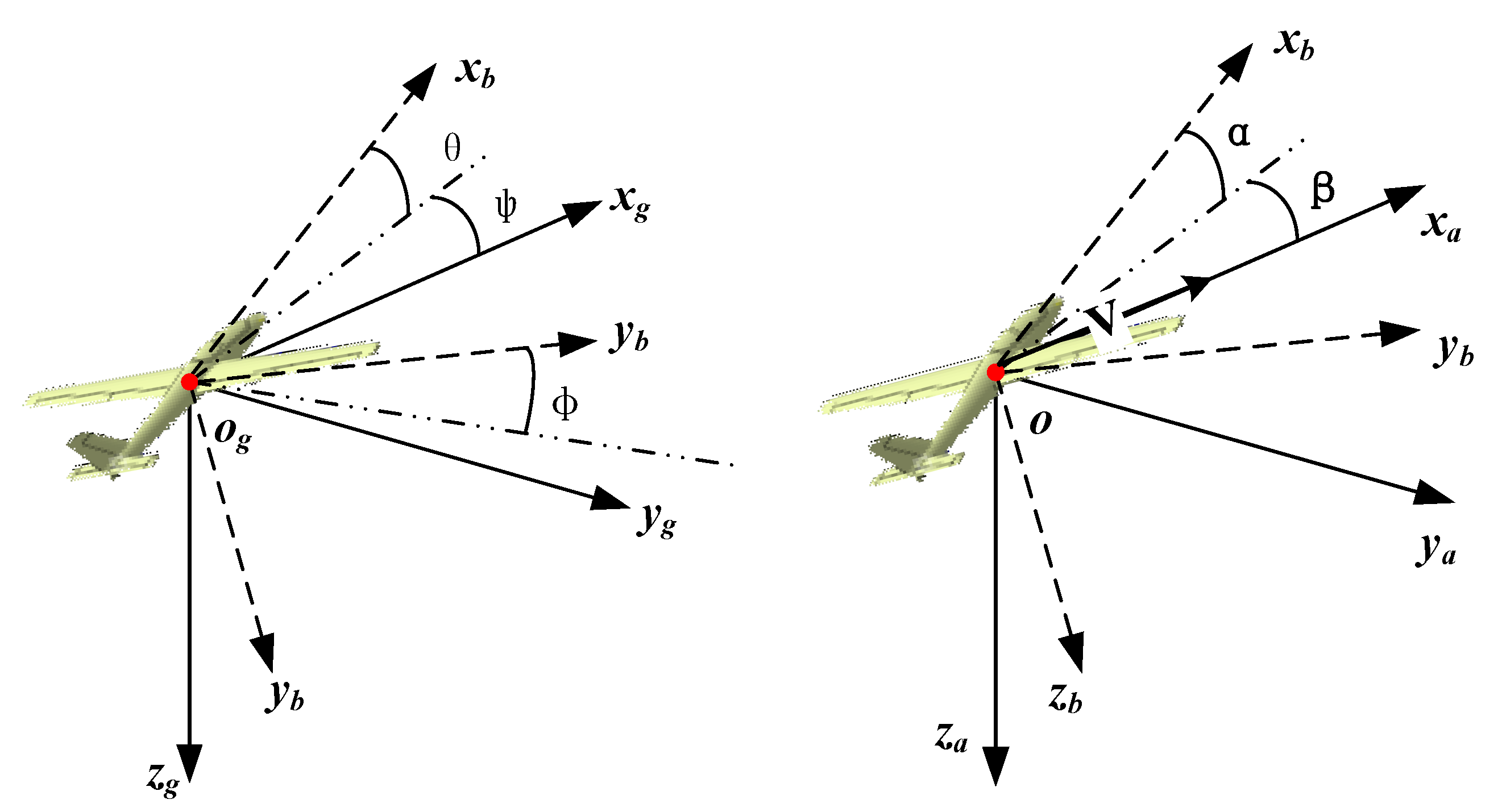
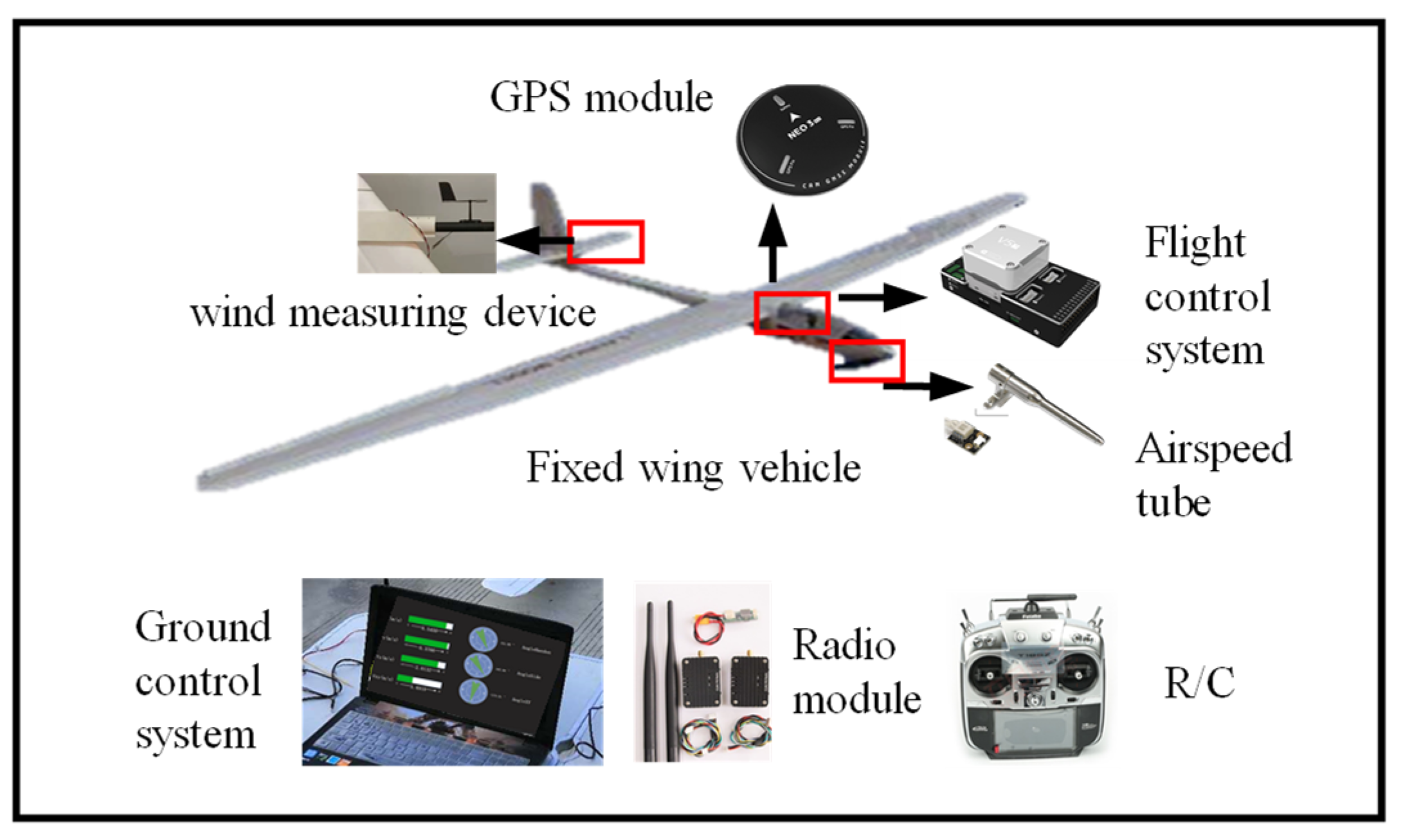
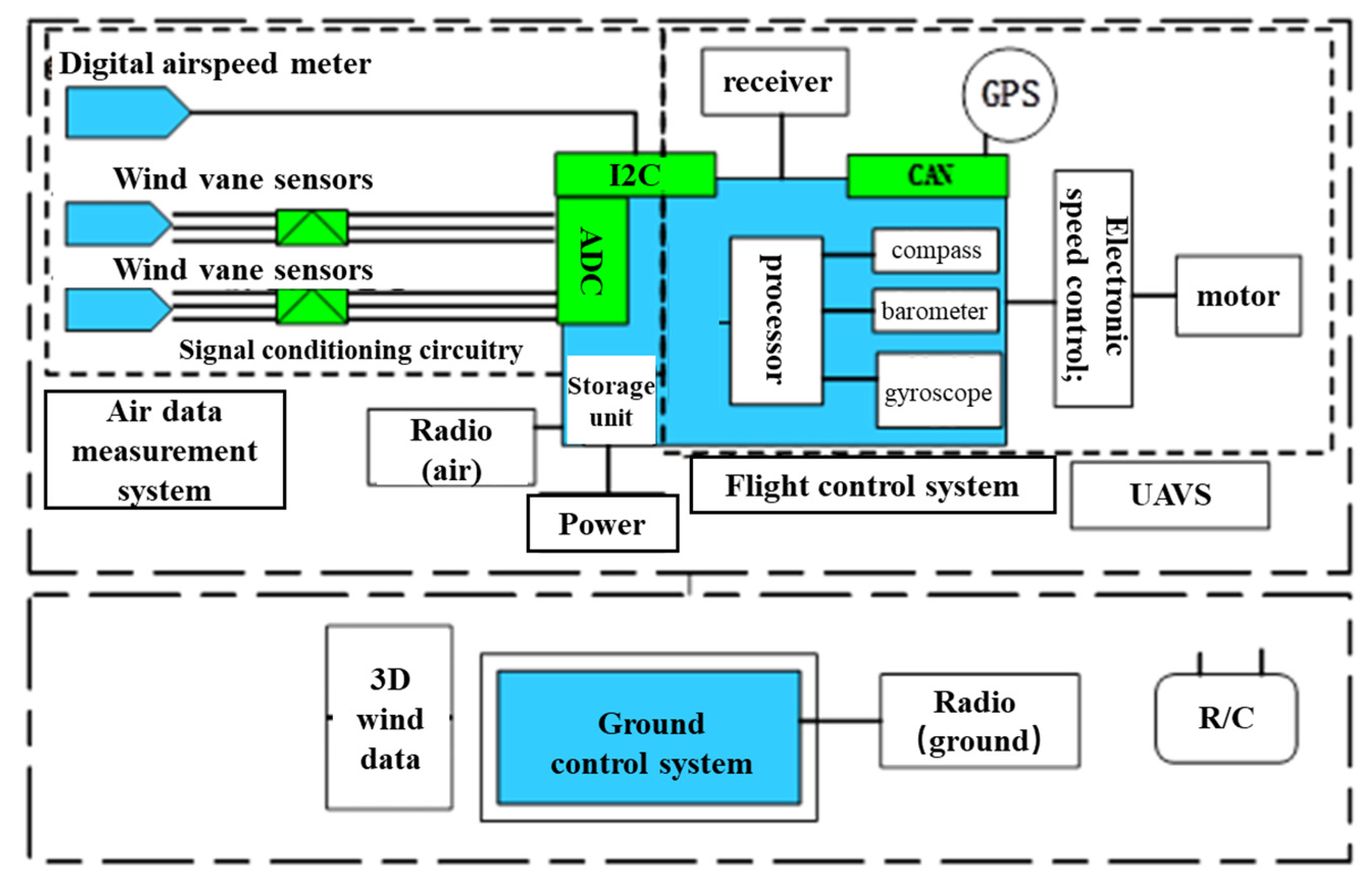

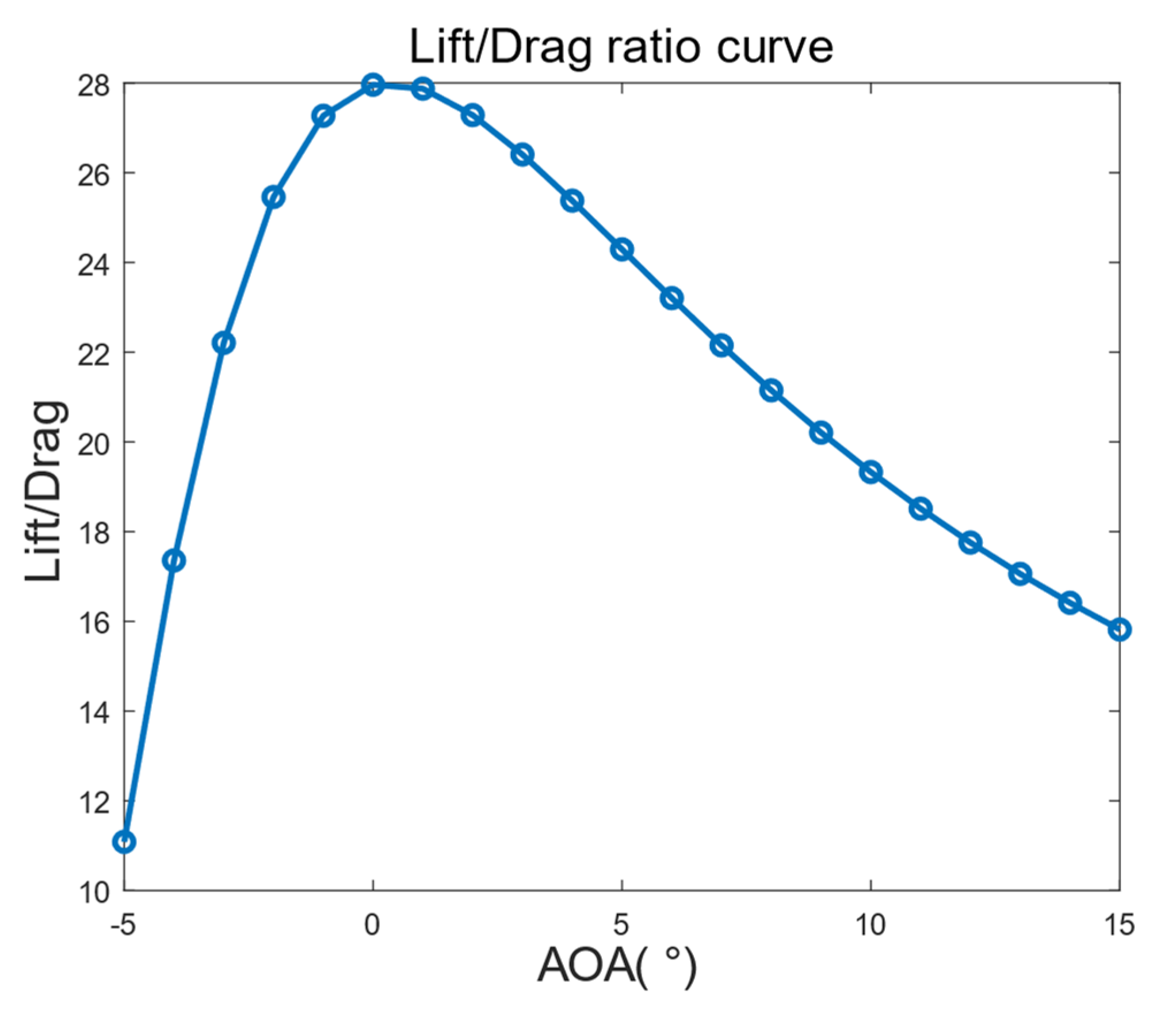
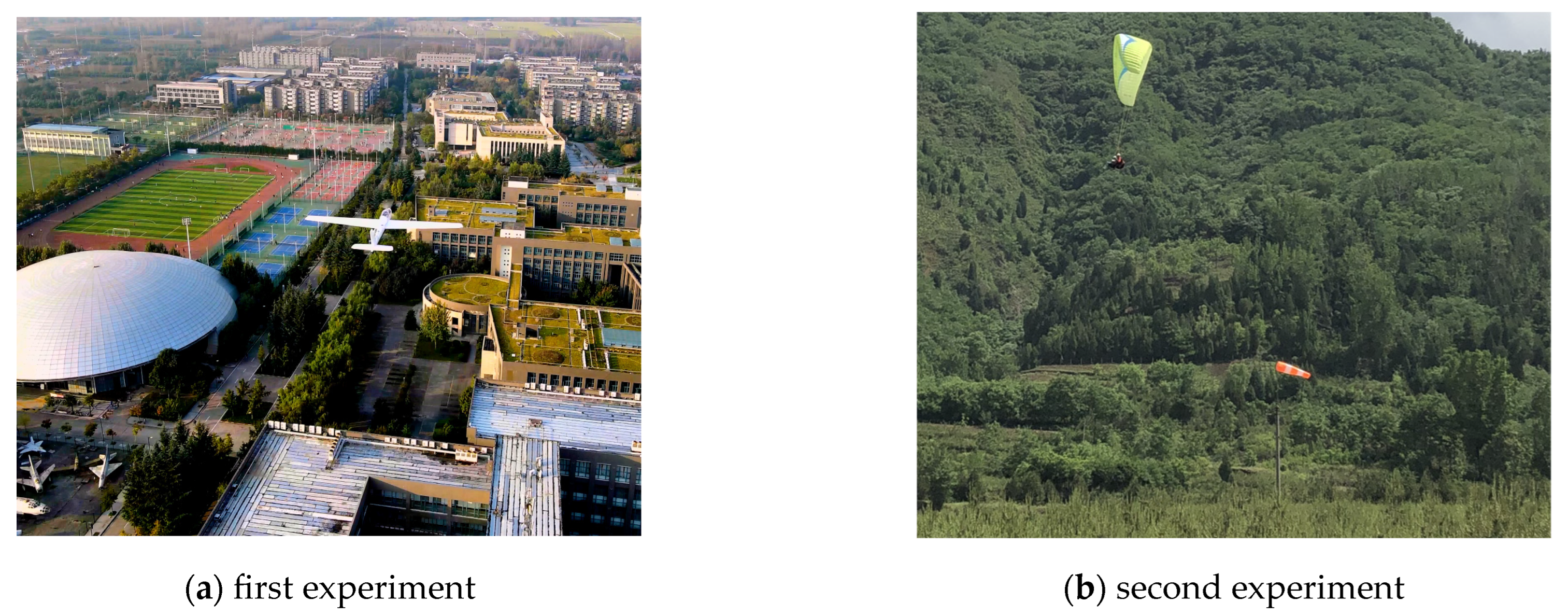
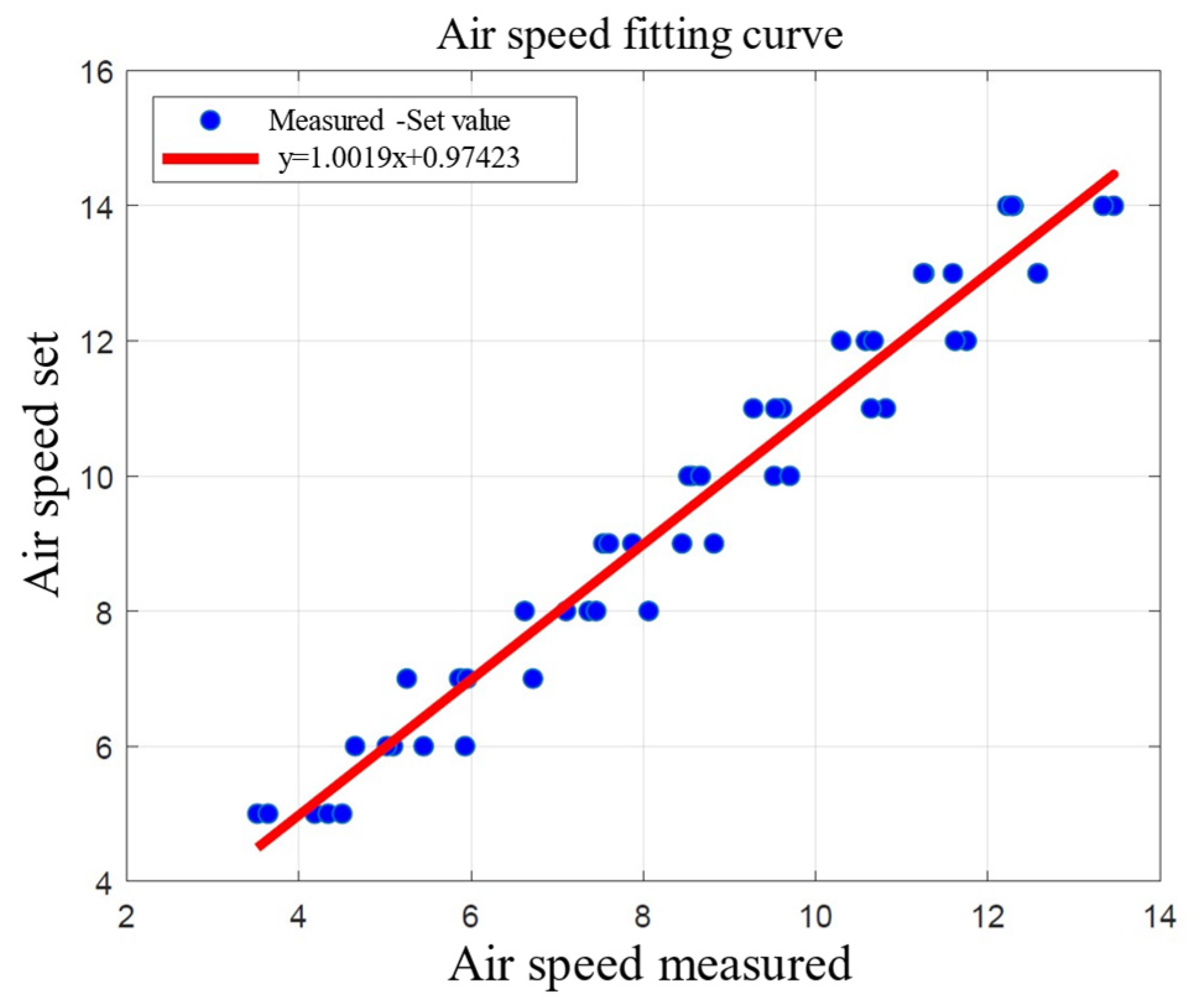
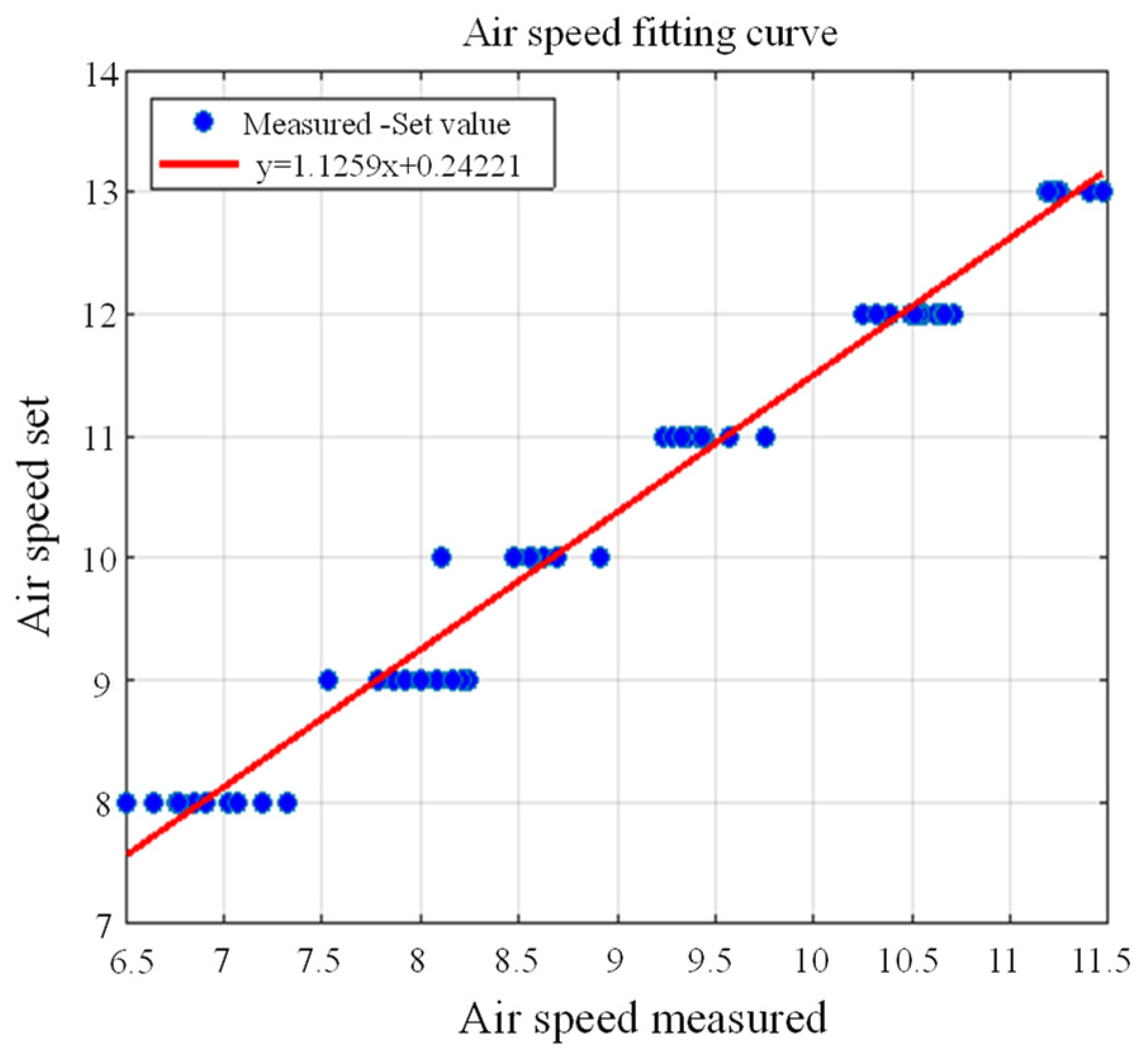
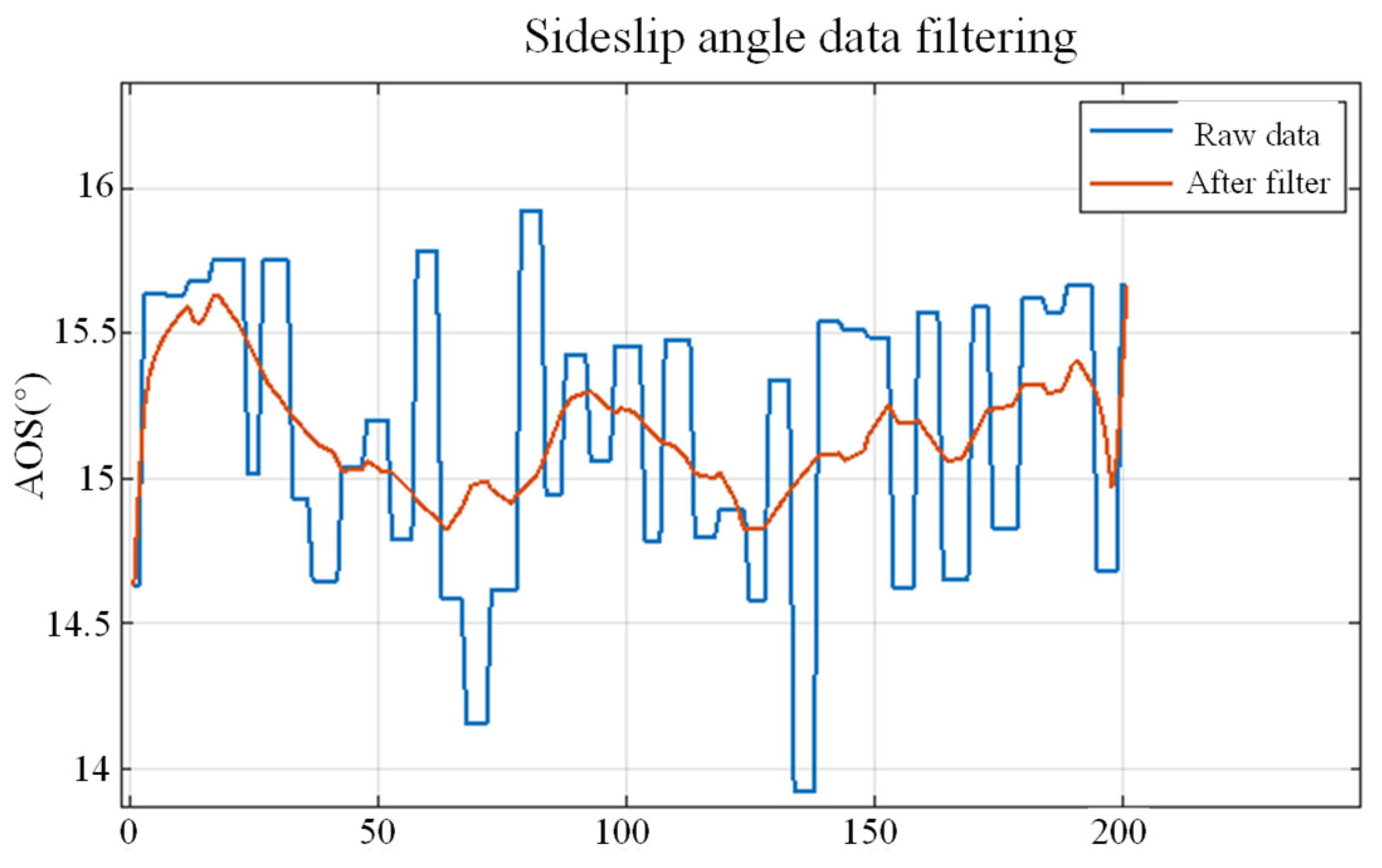
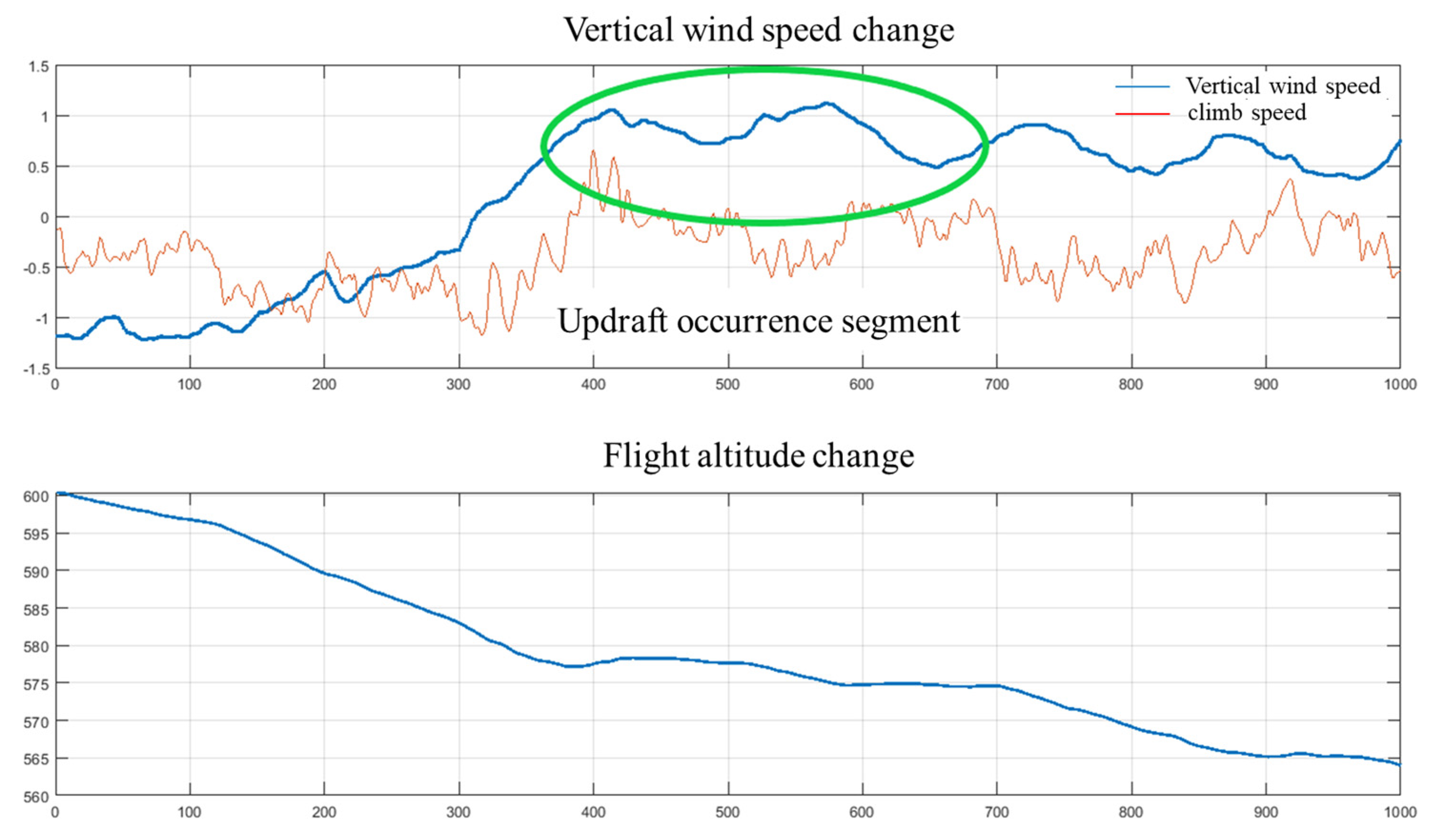

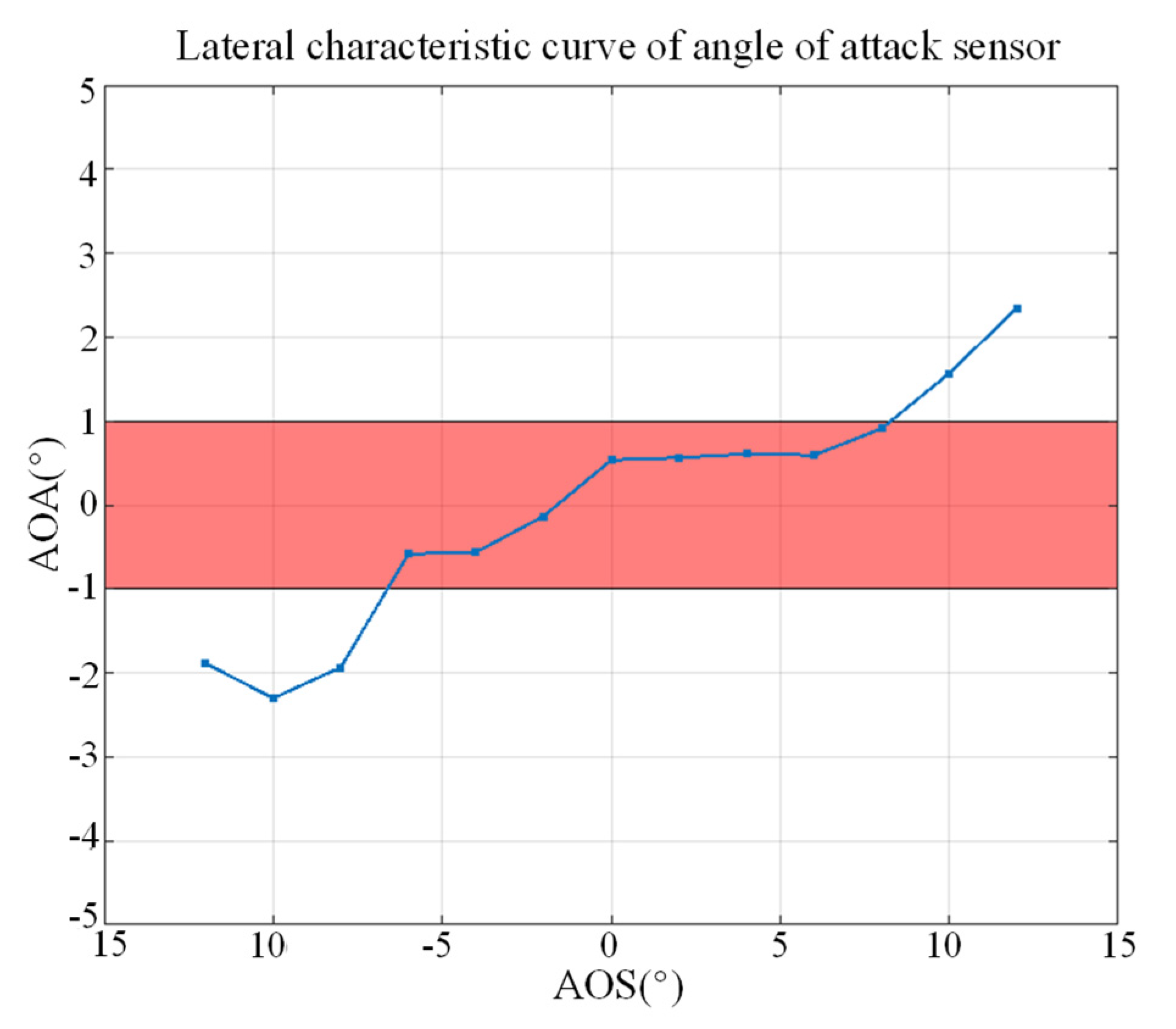
| Index | Value | Index | Value |
|---|---|---|---|
| Span | 3000 mm | Power | 22.2 V 5000 mAh Li-Po |
| Fuselage length | 1870 mm | Motor | 4258-KV460 |
| Endurance | 30 min | ESC | 70A |
| Wing loading | 64.5 g/dm2 | Servo | 23 g × 6 |
| Wing square | 36.2 dm2 | Propeller | 15 × 7.5 |
| Max take-off weight | 4900 g | Center of gravity | 9.2 cm (distance from wing leading edge) |
| Wind Speed | Scale Factor k1 | Intercept k2 | R2 | |
|---|---|---|---|---|
| 001 | 10 m/s | 0.6252 | 0.1993 | 0.9986 |
| 002 | 10 m/s | 0.6396 | 0.2839 | 0.9972 |
| summary | 10 m/s | 0.6319 | 0.2396 | 0.9977 |
| Wind Speed | Scale Factor k1 | Intercept k2 | R2 | |
|---|---|---|---|---|
| 001 | 10 m/s | 0.9086 | 0.1599 | 0.9989 |
| 002 | 10 m/s | 0.9350 | 0.0348 | 0.9967 |
| summary | 10 m/s | 0.9148 | 0.1030 | 0.9984 |
Disclaimer/Publisher’s Note: The statements, opinions and data contained in all publications are solely those of the individual author(s) and contributor(s) and not of MDPI and/or the editor(s). MDPI and/or the editor(s) disclaim responsibility for any injury to people or property resulting from any ideas, methods, instructions or products referred to in the content. |
© 2023 by the authors. Licensee MDPI, Basel, Switzerland. This article is an open access article distributed under the terms and conditions of the Creative Commons Attribution (CC BY) license (https://creativecommons.org/licenses/by/4.0/).
Share and Cite
Liu, L.; Song, B.; An, W.; Yang, X.; Xuan, J. A UAV Wind Field Perception System Inspired by Biological Perception. Appl. Sci. 2023, 13, 6743. https://doi.org/10.3390/app13116743
Liu L, Song B, An W, Yang X, Xuan J. A UAV Wind Field Perception System Inspired by Biological Perception. Applied Sciences. 2023; 13(11):6743. https://doi.org/10.3390/app13116743
Chicago/Turabian StyleLiu, Liu, Bifeng Song, Weigang An, Xiaojun Yang, and Jianlin Xuan. 2023. "A UAV Wind Field Perception System Inspired by Biological Perception" Applied Sciences 13, no. 11: 6743. https://doi.org/10.3390/app13116743
APA StyleLiu, L., Song, B., An, W., Yang, X., & Xuan, J. (2023). A UAV Wind Field Perception System Inspired by Biological Perception. Applied Sciences, 13(11), 6743. https://doi.org/10.3390/app13116743









